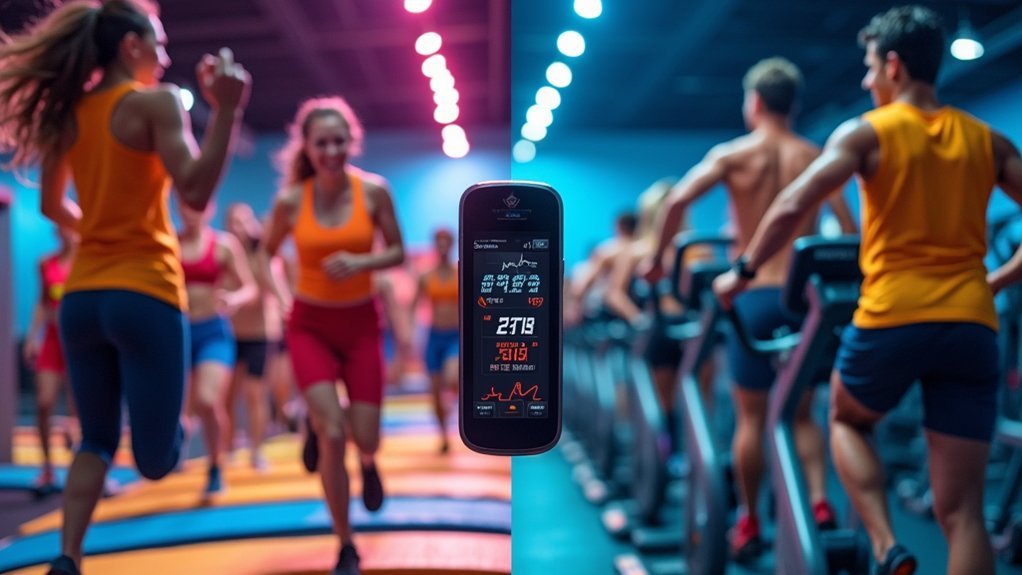Elliptical trainers typically burn more calories than trampolines, averaging 500-600 calories per hour compared to rebounding’s 250-400 calories. However, your weight, workout intensity, and duration greatly impact these numbers. Trampolines offer better joint protection and engage more stabilizing muscles, while ellipticals provide consistent lower-body conditioning. Your specific fitness goals and physical limitations should guide which equipment deserves a spot in your workout routine.
Understanding Calorie Burn Basics

When choosing between a trampoline and an elliptical, understanding how your body burns calories can help you make the right decision. Your physical attributes greatly impact calories burned during exercise, with heavier individuals generally expending more energy during the same activity.
Your fitness routine’s intensity and duration are equally important factors. High-intensity workouts on either machine will naturally yield greater caloric expenditure than moderate sessions.
Maximize your calorie burn by prioritizing workout intensity and length, not just equipment choice.
For instance, a vigorous 10-minute rebounding session can burn between 50-150 calories—comparable to running a 10-minute mile—while a steady pace on an elliptical typically burns around 500 calories per hour.
Adding resistance or incorporating Tabata-style intervals on either machine can dramatically increase your energy expenditure, making both options effective for weight management when used appropriately.
The Science Behind Rebounding Exercise
When you jump on a mini trampoline, you’re experiencing the unique physics of rebounding, where your body responds to fluctuating G-forces as high as 3.5 times normal gravity at the bottom of each bounce.
NASA research has confirmed these G-force impacts strengthen bones and muscles while improving lymphatic circulation more effectively than running.
Your body receives these benefits while burning 50-150 calories per 10 minutes, all without the joint stress associated with high-impact exercises.
Physics of Rebounding
Unlike traditional exercises that rely solely on muscular force, rebounding harnesses gravitational power and the elastic properties of the trampoline surface to create a unique workout experience.
When you jump, you’re converting kinetic energy into potential energy at the bounce’s peak, then back again as you descend.
This constant energy conversion is why rebounding burns an impressive 5-15 calories per minute—comparable to running a 10-minute mile, but without the harsh impact.
The trampoline absorbs approximately 80% of landing force, making it exceptionally low-impact on your joints while still delivering high-intensity results.
Your body experiences both upward and downward acceleration during each bounce, effectively engaging multiple muscle groups simultaneously and creating a gravitational challenge that your cardiovascular system must work harder to overcome.
G-Force Impact Benefits
Why does rebounding feel so different from other exercises? It’s all about the g-force impact, which can reach up to 3 times your body weight with each bounce.
This unique force creates a physiological environment that helps you burn more calories while protecting your joints.
- Your body experiences momentary weightlessness followed by gravity amplification, engaging more muscle fibers than traditional cardio.
- The calories per minute burned during rebounding can exceed walking or jogging due to the increased muscular engagement from g-force variations.
- Your lymphatic system gets a significant boost from the compression-decompression cycle, enhancing detoxification processes.
- The reduced impact on joints (compared to running) allows for longer, more sustainable workouts while still providing the intensity needed to burn more calories.
NASA Research Findings
These g-force benefits aren’t just anecdotal—they’re backed by serious scientific research from NASA. Their studies revealed that rebounding allows for calorie burning that’s up to 68% more efficient than jogging, while simultaneously engaging more muscle groups than traditional cardio exercises.
When you’re wondering “How Many Calories Does Rebounding Burn?” NASA’s research provides compelling evidence: the unique combination of gravitational forces and muscle engagement creates a metabolic sweet spot.
Additionally, their findings demonstrate improved cardiovascular health and enhanced lymphatic circulation during rebounding sessions.
High Quality Trampolines maximize these benefits by providing the ideal bounce surface for these physiological advantages. The low-impact nature of rebounding means you’ll experience less joint stress while still enjoying substantial calorie burn and improved bone density—making it a scientifically-validated exercise option.
How Elliptical Trainers Work the Body
When you step onto an elliptical trainer, you’re engaging multiple muscle groups simultaneously through a fluid, circular motion. The design provides a thorough workout that’s gentle on your joints while still delivering significant calorie-burning potential. Your elliptical machine can torch approximately 500 calories per hour during moderate sessions, making it an efficient fitness tool.
The elliptical’s gentle motion offers joint-friendly training while simultaneously activating muscles for maximum calorie burn.
- Your lower body gets primary attention—quadriceps, hamstrings, glutes, and calves all activate during each stride.
- Adjustable resistance and incline settings let you target specific muscle groups more intensely.
- Movable handlebars engage your upper body, creating a total-body workout experience.
- Built-in heart rate monitors help you track cardiovascular performance and maintain ideal training zones.
This low-impact workout option is particularly valuable for those with joint concerns or recovering from injuries.
Calorie Comparison: Real Numbers and Research

Research shows your body size greatly impacts calorie burn rates when choosing between trampolines and ellipticals.
While rebounding on a trampoline burns a modest 250-400 calories hourly, elliptical training aligns closer to traditional cardio exercises that can torch 500-600 calories per hour.
You’ll notice heavier individuals experience greater calorie expenditure on both machines, with a 208 lb person burning nearly twice as many calories as a 128 lb person during the same 10-minute rebounding session.
Actual Calorie Burn Rates
Four key factors determine your calorie burn when comparing trampolines to ellipticals: intensity, body weight, workout duration, and exercise type.
When examining the numbers, rebounding on a mini trampoline burns approximately 250-400 calories hourly, while high-intensity options can increase your results.
- A 128-pound person burns about 65 calories during a 10-minute low-intensity trampoline session.
- That same person burns 87 calories when increasing to high-intensity rebounding.
- Heavier individuals (208 pounds) can burn up to 138 calories in 10 minutes of low-intensity bouncing.
Running (600 calories/hour) and jump rope (700 calories/hour) outperform basic rebounding for calorie burning.
While trampolines offer a fun way to burn calories, other cardio equipment may provide more efficient energy expenditure.
Body Type Influences Results
Body composition greatly impacts your calorie-burning potential during exercise, as demonstrated by research comparing individuals of different weights using rebounders.
Heavier individuals like Alex (208 lbs) burned notably more calories (146 in 10 minutes) during high-intensity rebounding compared to lighter participants like Sydney (128 lbs), who expended only 87 calories in the same timeframe.
Your muscle mass plays an essential role in this equation—those with more muscle typically experience higher caloric burn due to increased metabolic rates.
Workout intensity further amplifies these differences; high-intensity rebounding sessions consistently yield greater calorie expenditure across all body types.
If you’re comparing your rebounding results to someone else’s, remember that body weight dramatically affects outcomes—heavier individuals naturally burn more calories on both trampolines and ellipticals.
Impact on Different Muscle Groups
While both fitness options deliver full-body benefits, trampolines and ellipticals engage muscles in distinctly different ways. Trampoline workouts demand constant stabilization, activating your core, quads, glutes, and leg muscles simultaneously as you bounce. This dynamic muscle engagement contributes to higher calorie burning than you might expect.
- Trampolines require continuous balance adjustments, strengthening often-neglected stabilizing muscles in your feet and ankles.
- Ellipticals primarily target lower body muscles with a predictable, controlled motion pattern.
- High-intensity trampoline sessions can incorporate strength movements for enhanced muscle development.
- Rebounding creates varied resistance through gravitational changes, improving both muscle strength and endurance.
You’ll find that while ellipticals offer reliable lower-body conditioning, trampolines deliver more thorough muscle engagement through their unpredictable, multi-directional movements.
Heart Rate Elevation: Trampoline vs. Elliptical

When it comes to cardiovascular benefits, trampolines and ellipticals offer distinct approaches to elevating your heart rate. Rebounding on a trampoline delivers surprisingly intense cardio workouts, often surpassing elliptical training in heart rate elevation. Committing to rebounds for 30 days could greatly improve your cardiovascular fitness.
| Aspect | Trampoline | Elliptical |
|---|---|---|
| Heart Rate Impact | Higher sustained rates | Moderate, controllable |
| Intensity Level | Naturally high-intensity | Adjustable resistance |
| Muscle Engagement | Full-body + core | Primarily lower body |
| 10-Minute Workout | Significant HR increase | Gradual HR elevation |
| Calorie Burn | Higher due to muscle engagement | Dependent on resistance |
While both activities meet cardiorespiratory fitness guidelines, trampoline workouts engage more muscle groups simultaneously, naturally keeping your heart rate elevated throughout the session compared to the more controlled pace of elliptical training.
The Role of Workout Duration and Intensity
The duration and intensity of your workout greatly shape your fitness outcomes, regardless of whether you choose a trampoline or elliptical.
Consistent effort at your optimal intensity level drives results, whether bouncing or striding.
While moderate rebounding burns 250-400 calories hourly, high-intensity trampoline sessions can reach 12.4 calories per minute—significantly outpacing low-intensity workouts at 6.9 calories per minute.
- High-intensity rebounding often yields better calorie burn than steady-state elliptical training
- Adding strength movements to your trampoline routine enhances caloric expenditure
- Traditional running at 6 mph burns about 600 calories hourly—use this as a benchmark
- Your workout duration directly impacts total calories burned, so longer sessions at appropriate intensity levels maximize results
If you’re seeking maximum calorie burn in limited time, intensity matters more than your choice of equipment, though trampolines often provide greater engagement and variety.
Joint Health and Safety Considerations
As you consider which exercise equipment to invest in, joint health should factor prominently in your decision-making process.
Mini trampolines offer distinctive advantages in this area, providing low-impact workouts that notably reduce stress on your knees and ankles compared to running.
The trampoline’s elastic surface absorbs impact during rebounding, making it particularly suitable if you have joint concerns. You’ll experience complex movements without the joint strain that often accompanies high-impact exercises.
This gentle approach doesn’t compromise effectiveness—you’re still strengthening essential muscles in your feet and calves that improve balance.
For older adults or those with existing joint issues, trampolines present a safer option that supports pelvic floor health while minimizing injury risk.
When joint health is a priority, rebounding offers a gentler alternative without sacrificing fitness benefits.
Additional Health Benefits Beyond Calories
Looking beyond mere calorie burn, both trampolines and ellipticals offer distinctive health advantages that greatly impact your overall wellbeing.
While ellipticals provide steady cardiovascular benefits, rebounding’s unique up-and-down motion delivers exceptional lymphatic circulation support and detoxification benefits you won’t find elsewhere.
- Trampolining strengthens your feet, ankle, and calf muscles, dramatically improving balance and coordination while reducing fall risk.
- As a low-impact exercise, rebounding protects your joints while still delivering effective cardiovascular conditioning.
- Regular trampoline workouts can enhance pelvic floor function, offering benefits many traditional exercises don’t provide.
- The playful nature of rebounding creates opportunities for social interaction and stress reduction, adding emotional health benefits to your physical workout routine.
Creating an Effective Fitness Routine
Designing an effective fitness routine requires strategic balancing of both trampoline and elliptical workouts to maximize your results.
Alternate between low-impact rebounding sessions and higher-intensity elliptical training to enhance calorie burn while protecting your joints.
Balance trampoline rebounding with elliptical intensity for maximum calorie burn and minimal joint stress.
For ideal benefits, mix workout intensities throughout your week. A high-intensity trampoline workout can burn 146 calories in just 10 minutes, while longer elliptical sessions provide steady calorie expenditure.
Incorporate variety by adding jumping jacks and sprints to your trampoline workouts, and resistance training on the elliptical.
Regularly evaluate your progress and adjust your fitness routine based on your goals and preferences.
Remember that sustainability is key—choose physical activity combinations you enjoy to maintain long-term commitment and achieve lasting results.
Which Exercise Fits Your Lifestyle and Goals
When deciding between a trampoline and an elliptical, your personal lifestyle and fitness objectives ultimately determine which equipment will serve you best.
Rebounding on a fitness trampoline offers a fun, low-impact workout burning 250-400 calories hourly, while ellipticals provide more intense sessions at around 500 calories per hour.
Consider these factors when making your choice:
- Your personal fitness goals: weight loss, balance improvement, or joint health
- Available time: shorter, more intense elliptical sessions versus longer, enjoyable rebounding workouts
- Physical limitations: rebounding is gentler on joints while still effective
- Enjoyment factor: you’re more likely to stick with an exercise you actually look forward to
Combining both activities can create a well-rounded fitness routine that prevents workout boredom while addressing different aspects of your health.
Frequently Asked Questions
What Is 10 Minutes on a Trampoline Equivalent To?
Ten minutes on a trampoline is equivalent to running a 10-minute mile. You’ll burn between 50-150 calories depending on your weight and intensity, while engaging multiple muscle groups and improving your core strength.
How Many Calories Do 30 Minutes of Trampoline Burn?
You’ll burn between 150-450 calories during a 30-minute trampoline workout, depending on your weight and intensity. Low-intensity rebounding burns around 6.9 calories per minute, while high-intensity sessions can reach 12.4 calories per minute.
Is 30 Minutes a Day on the Elliptical Enough to Lose Weight?
Thirty minutes daily on the elliptical can help you lose weight by creating a calorie deficit. You’ll see better results when you combine it with proper nutrition and add strength training to your routine.
Is Jumping on a Trampoline Good for Weight Loss?
Yes, jumping on a trampoline is great for weight loss. You’ll burn 250-400 calories per hour while strengthening your core and legs. It’s low-impact on your joints and fun, so you’re more likely to stick with it.
In Summary
You’ll burn more calories on an elliptical (generally 400-600 calories per hour) compared to a trampoline (around 200-400 calories hourly). However, your best choice depends on your fitness goals, joint health, and personal enjoyment. Remember, consistency matters most—you’ll stick with exercise you actually enjoy doing. Consider incorporating both into your routine for variety and to target different muscle groups while keeping your fitness journey sustainable.





Leave a Reply